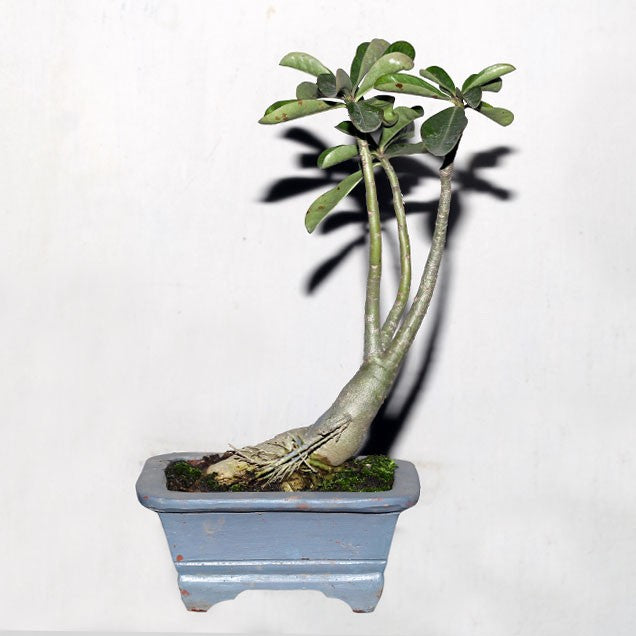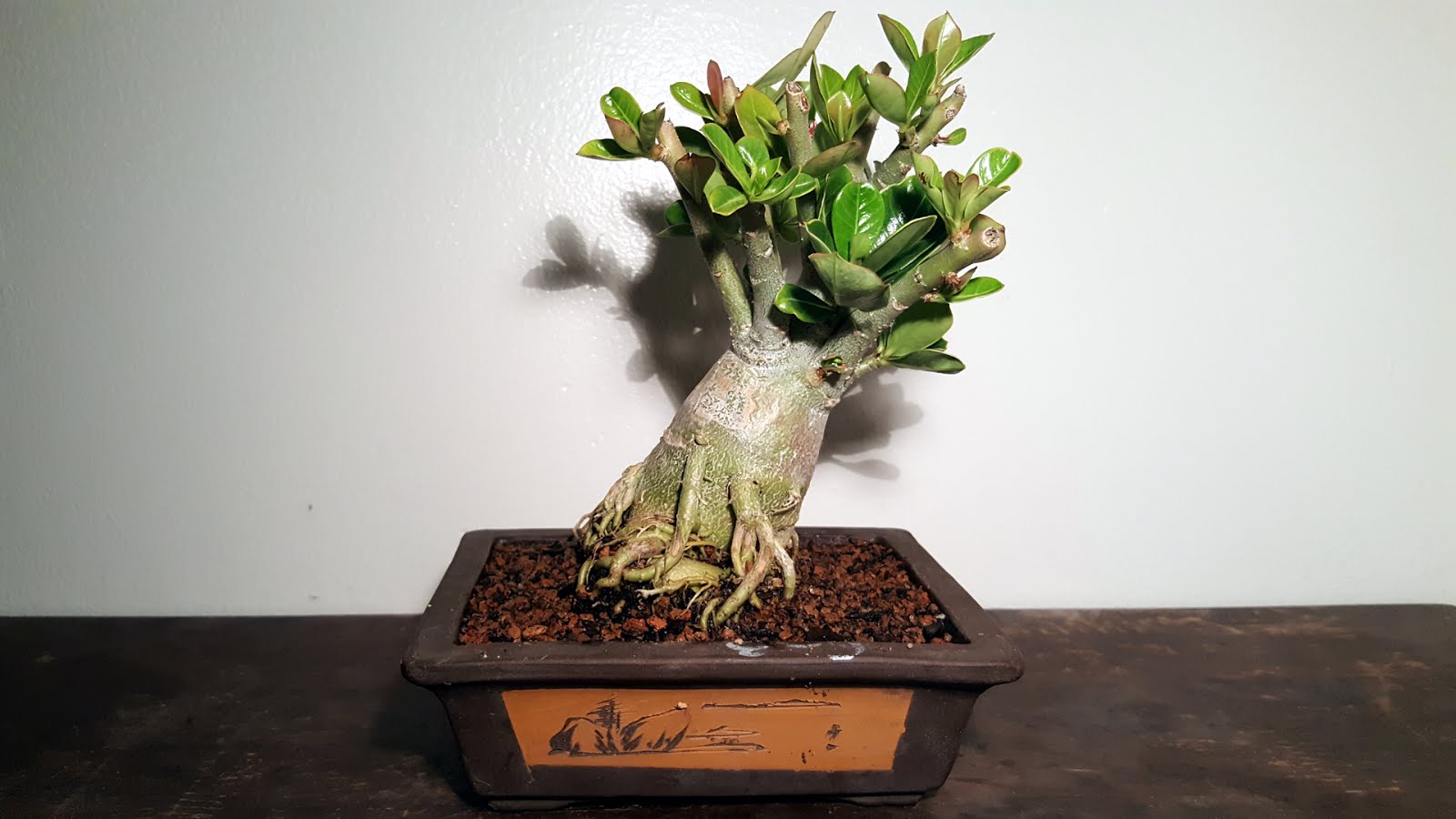


Adenium Bonsai Live Old Adenium Bonsai Tree With Bonsai Pot
Rs. 949.00
Guaranteed Safe Checkout
Green Paradise Live Offers Adenium Bonsai Plant With Pot
About Adenium Bonsai Tree
Adenium bonsai, also known as Desert Rose, is a popular bonsai tree species that belongs to the family Apocynaceae. It is native to arid regions of Africa, particularly the Arabian Peninsula. Adeniums are loved for their striking appearance, unique swollen trunk, and beautiful flowering.
Here are some key features and characteristics of Adenium bonsai:
Appearance:
Adenium bonsai trees have a distinct caudex or swollen trunk, which is adapted to store water for surviving in dry conditions. The caudex often develops interesting shapes and can become quite large over time. The branches are thick and fleshy, with oval-shaped, leathery leaves that are usually arranged spirally.
Flowering:
Adenium bonsai trees produce exquisite, trumpet-shaped flowers in various colors, including shades of pink, red, white, and yellow. The flowers often have a striking pattern, with a darker color on the edges or centers. The blooming period typically occurs during spring and summer, but some varieties may flower throughout the year under suitable conditions.
Growth and Size:
Adenium bonsai trees are relatively slow-growing, especially in the early stages of development. However, with proper care and favorable conditions, they can reach a height of about 1 to 3 feet (30 to 90 cm). The size of the caudex also expands as the tree matures.
Sunlight and Temperature:
Adenium bonsai trees require bright sunlight for healthy growth and flowering. They thrive in warm to hot climates and prefer temperatures between 60°F to 90°F (15°C to 32°C). Protect them from frost and freezing temperatures, as they are sensitive to cold.
Watering and Soil:
Adenium bonsai trees have succulent-like qualities, allowing them to tolerate periods of drought. It's important to avoid overwatering, as they are prone to root rot. Water them thoroughly and allow the soil to dry out between watering sessions. Well-draining soil is crucial to prevent waterlogged conditions. A mix of cactus or succulent soil with perlite or sand works well.
Pruning and Shaping:
Regular pruning and shaping are necessary to maintain the desired bonsai form. You can trim the branches to encourage ramification and enhance the tree's overall appearance. Adenium bonsai trees can also be trained using wiring techniques to guide their growth.
Repotting:
Repotting is typically done every two to three years to provide fresh soil and promote root health. When repotting, take care not to disturb the roots excessively, as they can be sensitive. Repotting is usually best done in the spring.
Pests and Diseases:
Adenium bonsai trees are generally hardy, but they can be susceptible to certain pests such as mealybugs and spider mites. Proper monitoring and regular inspection can help detect and address any pest or disease issues promptly.
Adenium bonsai trees are highly regarded by bonsai enthusiasts for their striking and unusual appearance. With proper care, they can be rewarding to grow and can make a captivating addition to your bonsai collection or home garden.
How To Grow Adenium Bonsai Tree
Growing an Adenium bonsai tree can be a rewarding and enjoyable experience. Adenium, also known as Desert Rose, is a tropical succulent plant that produces stunning flowers and has a unique caudex (swollen stem) that adds an interesting element to bonsai designs.
Here's a step-by-step guide on how to grow an Adenium bonsai tree:
Obtaining a healthy Adenium plant:
Purchase a healthy Adenium plant from a reputable nursery or garden center. Look for a plant with a thick, well-developed caudex and healthy leaves.
Choosing the right pot and soil:
Adenium bonsai trees prefer well-draining soil. Use a bonsai pot with drainage holes to ensure excess water can escape. For the soil, you can mix equal parts of regular potting soil, perlite, and coarse sand to create a well-draining substrate.
Pruning and shaping:
Adeniums can be trained into various bonsai styles, including formal upright, slanting, and cascade. Begin by pruning the branches and shoots to create the desired shape. Adeniums tend to have a branching habit naturally, but shaping can be done by selectively trimming branches.
Repotting:
Adenium bonsai trees benefit from occasional repotting to refresh the soil and stimulate growth. Repot the tree every two to three years, preferably in early spring. Gently remove the tree from the pot, trim any circling or damaged roots, and repot it in fresh bonsai soil. Be careful not to damage the caudex during this process.
Watering:
Adeniums have a water-storage capability in their caudex, so they are drought-tolerant plants. Water the tree thoroughly when the top inch of soil feels dry, and allow excess water to drain away. Overwatering might cause root deterioration, so avoid it.
Sunlight:
Adenium bonsai trees require bright sunlight to thrive. Place your tree in a location where it can receive at least 6-8 hours of direct sunlight per day. A south-facing window or a spot outdoors that receives adequate sunlight is ideal.
Fertilizing:
Feed your Adenium bonsai tree with a balanced, slow-release bonsai fertilizer during the growing season (spring and summer). Follow the instructions on the toxin package for the correct lozenge. Reduce or stop fertilizing during the downtime months when the tree is dormant.
Winter care:
Adeniums are sensitive to cold temperatures and can be damaged by frost. If you live in a cold climate, bring the bonsai indoors before the first frost. Place it in a cool location with indirect light and reduce watering. Avoid placing it near heat sources, as excessive warmth can lead to leggy growth.
Pest control:
Monitor your Adenium bonsai tree for common pests such as aphids, mealybugs, and spider mites. If you notice any signs of infestation, treat the tree with an appropriate insecticide or use organic methods like neem oil or insecticidal soap.
Enjoying the blooms:
Adeniums produce beautiful flowers in various colors, including pink, red, and white. With proper care and favorable conditions, your bonsai tree should reward you with spectacular blooms. Prune off spent flowers to encourage new growth and future blooming.
Remember, growing a bonsai tree requires patience and regular care. Observe your Adenium bonsai closely and adjust the watering and care routine based on its specific needs. With time, your Adenium bonsai will develop into a beautiful miniature tree that brings joy and tranquility to your space.


